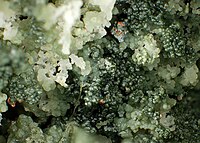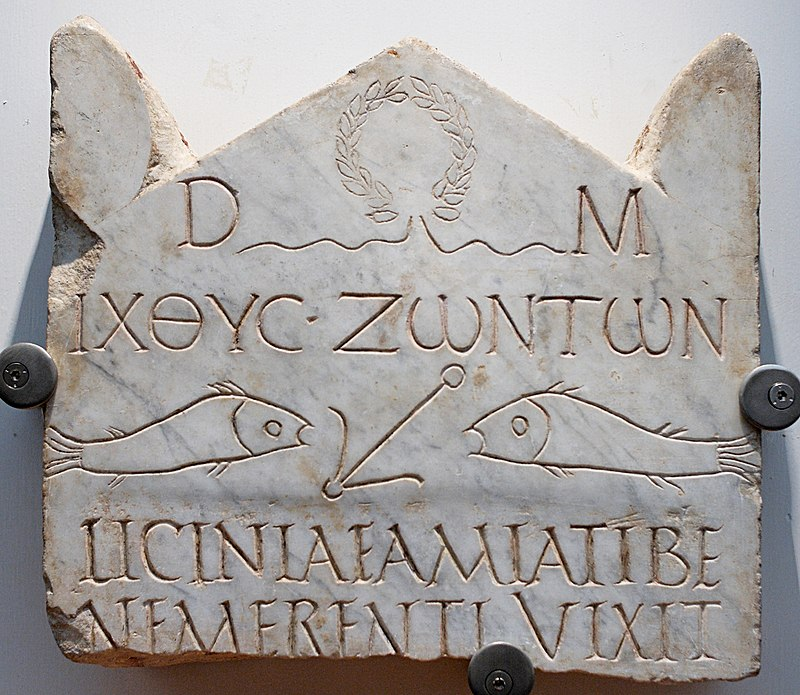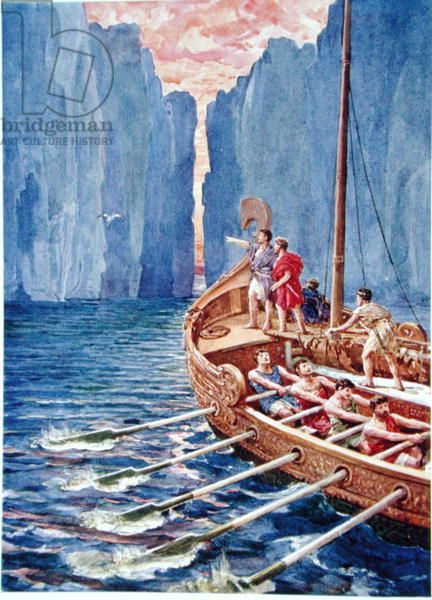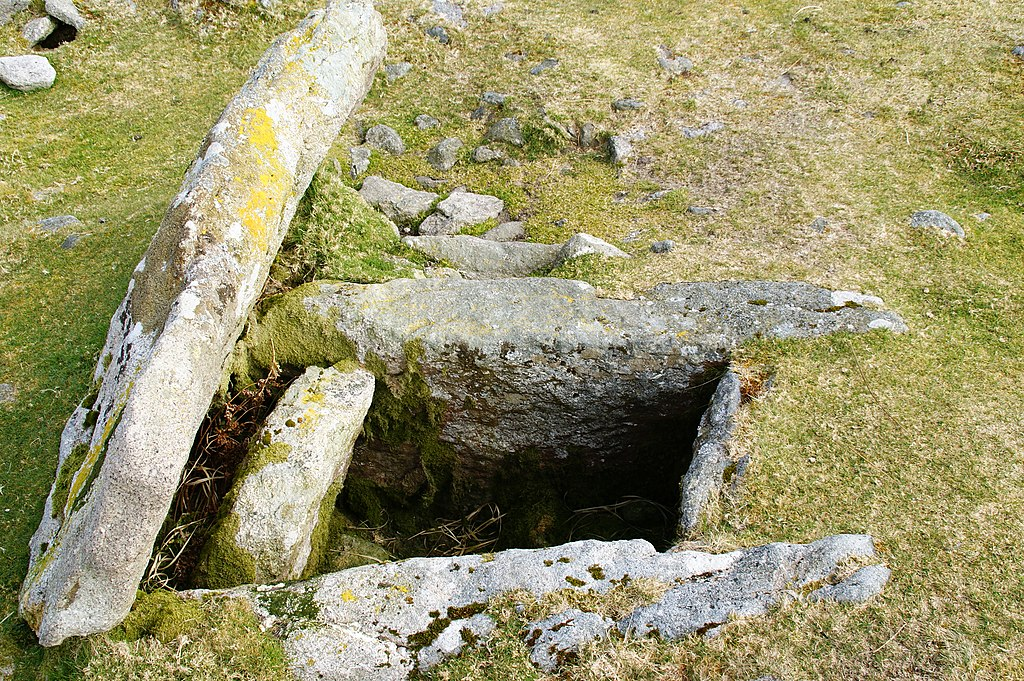Tag: Rocks
-

Laterite
Laterite is a soil type rich in iron and aluminium and is commonly considered to have formed in hot and wet tropical areas. Nearly all laterites are of rusty-red coloration, because of high iron oxide content. They develop by intensive and prolonged weathering of the underlying parent rock, usually when there are conditions of high temperatures and heavy rainfall with alternate wet and dry periods. The…
-

Saprolite
Saprolite is a chemically weathered rock. Saprolites form in the lower zones of soil profiles and represent deep weathering of the bedrock surface. In most outcrops, its color comes from ferric compounds. Deeply weathered profiles are widespread on the continental landmasses between latitudes 35°N and 35°S. Conditions for the formation of deeply weathered regolith include a topographically moderate relief flat enough to prevent erosion and to allow leaching of the products of chemical weathering. A second…
-

Detritus (geology)
Detritus is particles of rock derived from pre-existing rock through weathering and erosion. A fragment of detritus is called a clast. Detrital particles can consist of lithic fragments (particles of recognisable rock), or of monomineralic fragments (mineral grains). These particles are often transported through sedimentary processes into depositional systems such as riverbeds, lakes or the ocean, forming sedimentary successions. Diagenetic processes can transform these sediments into rock through cementation and lithification, forming…
-

Diagenesis (the Petrologic principle)
Diagenesis is the process that describes physical and chemical changes in sediments first caused by water-rock interactions, microbial activity, and compaction after their deposition. Increased pressure and temperature only start to play a role as sediments become buried much deeper in the Earth’s crust. In the early stages, the transformation of poorly consolidated sediments into sedimentary rock (lithification) is simply accompanied by a reduction in porosity…
-

Flame Test
A flame test is relatively quick test for the presence of some elements in a sample. The technique is archaic and of questionable reliability, but once was a component of qualitative inorganic analysis. The phenomenon is related to pyrotechnics and atomic emission spectroscopy. The color of the flames is understood through the principles of atomic electron transition and photoemission, where varying elements require distinct energy levels (photons)…
-
On the pathology of miner’s lung (1875)
and a history of phagocytosis (and athletic fish flakes)
-

Langgan 琅玕 is the ancient Chinese name of a gemstone which remains an enigma in the history of mineralogy; it has been identified, variously, as blue-green malachite, blue coral, white coral, whitish chalcedony, red spinel, and red jade
It is also the name of a mythological langgan tree of immortality found in the western paradise of Kunlun Mountain, and the name of the classic waidan alchemical elixir of immortality langgan huadan 琅玕華丹 “Elixir Efflorescence of Langgan”. Waidan, translated as ‘external alchemy‘ or ‘external elixir‘, is the early branch of Chinese alchemy that focuses upon compounding elixirs of immortality by heating minerals, metals, and other natural substances…
-

In Chinese alchemy, elixir poisoning refers to the toxic effects from elixirs of immortality that contained metals and minerals such as mercury and arsenic
In Chinese alchemy, elixir poisoning refers to the toxic effects from elixirs of immortality that contained metals and minerals such as mercury and arsenic. The official Twenty-Four Histories record numerous Chinese emperors, nobles, and officials who died from taking elixirs to prolong their lifespans. The first emperor to die from elixir poisoning was likely Qin Shi Huang (d. 210 BCE) and the last was the Yongzheng Emperor (d. 1735 CE). Despite common knowledge…
-

Cold-Food Powder or Five Minerals Powder, poisonous psychoactive drug popular during the Six Dynasties (220–589) and Tang dynasty (618–907)
Cold-Food Powder (Chinese: 寒食散; pinyin: hánshísǎn; Wade–Giles: han-shih-san) or Five Minerals Powder (Chinese: 五石散; pinyin: wǔshísǎn; Wade–Giles: wu-shih-san) was a poisonous psychoactive drug popular during the Six Dynasties (220–589) and Tang dynasty (618–907) periods of China. Terminology Both Chinese names hanshisan and wushisan have the suffix -san (散, lit. “fall apart; scattered”), which means “medicine in powdered form” in Traditional Chinese medicine. Wushi (lit. “five rock”) refers to the component mineral drugs, typically: fluorite, quartz, red bole clay, stalactite, and sulfur. Hanshi (lit. “cold food”) refers to eating cold foods and bathing in cold water…
-

Manes or Di Manes
In ancient Roman religion, the Manes or Di Manes are chthonic deities sometimes thought to represent souls of deceased loved ones. They were associated with the Lares, Lemures, Genii, and Di Penates as deities (di) that pertained to domestic, local, and personal cult. They belonged broadly to the category of di inferi, “those who dwell below,” the undifferentiated collective of divine dead. The Manes were honored during the Parentalia and Feralia in February.…
-

Jason and the Argonauts and the dove
The Symplegades or Clashing Rocks, also known as the Cyanean Rocks, were, according to Greek mythology, a pair of rocks at the Bosphorus that clashed together whenever a vessel went through. They were defeated by Jason and the Argonauts, who would have been lost and killed by the rocks except for Phineus‘ advice. Jason let a dove fly between the rocks to see exactly how fast…
-

Kist or Cist and Kistivan
A kistvaen or cistvaen is a tomb or burial chamber formed from flat stone slabs in a box-like shape. If set completely underground, it may be covered by a tumulus. The word is derived from the Welsh cist (chest) and maen (stone). The term originated in relation to Celtic structures, typically pre-Christian, but in antiquarian scholarship of the 19th and early 20th centuries it was sometimes applied to similar structures outside the Celtic world. One…
-
Passage graves – neolithic luxury condos for the dead
Imagine you’re a Neolithic farmer with a flair for architecture and a penchant for dramatic burials. What do you build? A passage grave, of course! These stone-age structures are the ultimate “tight squeeze” for the dearly departed. A passage grave, also known as a passage tomb (because nothing says “final resting place” like a narrow…
-

Autochthon and allochthon
An autochthon in structural geology is a large block or mass of rock which is in the place of its original formation relative to its basement or foundation rock. It can be described as rooted to its basement rock as opposed to an allochthonous block or nappe which has been relocated from its site of formation usually by low angle thrust faulting. For other possible mechanisms see obduction.…
-

Terminus (Roman god)
In Roman religion, Terminus was the god who protected boundary markers; his name was the Latin word for such a marker. Sacrifices were performed to sanctify each boundary stone, and landowners celebrated a festival called the “Terminalia” in Terminus’ honor each year on February 23. The Temple of Jupiter Optimus Maximus on the Capitoline Hill was thought to have been built over a shrine to Terminus, and…
-
Herma
Picture this: You’re strolling through a classical Greek agora, minding your own business, when BAM! You’re face-to-face with a square pillar sporting a head, maybe some pecs if you’re lucky, and – oh, hello there! – a rather prominent set of male genitalia at eye level. Talk about art that grabs your attention! These saucy…
NOTES
- 🧬 Disease Table with Low Sodium Connection
- 🧂 Sodium Reduction and Sodium Replacement: A History of Reformulation and Exploding Diseases, Including Many Diseases Unheard of Before Deadly Sodium Policies
- 🧂 The DEADLY 1500 mg Sodium Recommendation predates the WHO’s formal global sodium reduction push by nearly a decade (and it’s even worse than that)
- 🧬 What Is Beta-Glucuronidase?
- When Sugar Was Salt: Crystalline Confusion and the Covenant of Sweetness
Tags
ADAM ASPARTAME Birds Blood Bones Brain Bugs Cancer Columba Cows crystallography Death Death cults Eggs Etymology Gastrin Gold Growth hormone History Hormones Insulin Liver Mere Perplexity Metal Monkey Business Mythology Paracetamol Plants Poison Pregnancy Protein Religion Reproduction Rocks Salt Slavery Snakes Sodium the birds and the bees Thiocyanate Tobacco Tylenol Underworld Venom zinc

